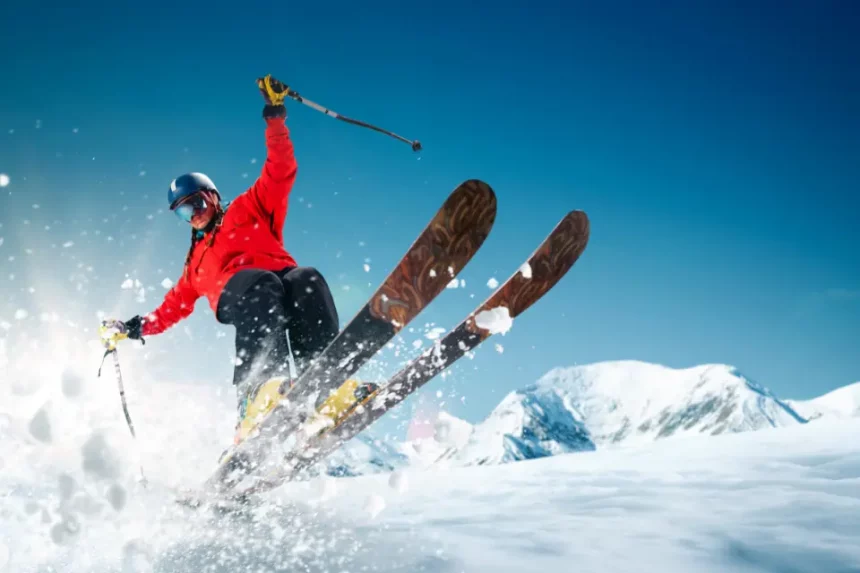Skiing is one of the best winter activities around! Whether you’re a beginner aiming to learn how to ski, or an experienced skier looking to brush up on your technique, this ultimate guide to skiing is here to help. With our tips and tricks, you’ll be ready for a successful season on the slopes.
From choosing the right equipment to mastering the basics, we’ve got you covered. Learn how to stay safe and enjoy your time on the mountain. With the right preparation and knowledge, you can make the most of the season and have a blast!
1. Choosing the right equipment
First things first, let’s talk about the gear. Skiing isn’t cheap, so it’s important to know what you need for a successful season. Here are some basics to get you started. Ski Boots – Ski boots are designed to hold your foot in a precise position to maximize the transfer of energy from your legs to your skis. The right boot can make a huge difference in your skiing experience. If you haven’t bought ski boots in a while, make sure you try on a few pairs to find the right fit.
Ski Goggles – Ski goggles are essential to protect your eyes from the sun and cold. There are two basic types of ski goggles, and you’ll want to make sure you choose the right type. If you’re a beginner, or planning to spend most of your time indoors, go with a soft-foam type.
If you plan to spend most of your time outside, with varying light conditions, choose a hard-foam type. Skiing Helmet – If you’re skiing in the terrain park or off-piste, you’ll want to make sure you have a helmet. They are recommended for all skiers and snowboarders, no matter their level of experience.
2. Mastering the basics
If you’re a beginner, mastering the basics is crucial to a successful season. Here are some things to keep in mind when learning how to ski. Weight Transfer – Your weight should be slightly towards the front of the skis, with your back knee slightly bent.
Keep your weight centered to maintain control and avoid falling. Stance – Your stance will depend on your ability level, but one way to find a good stance is to stand with your feet together and then place your skis where your feet are. Your skis should be slightly wider than your hips. Look Ahead – Always look down the hill, not at your skis, to maintain control.
3. Staying safe on the slopes
When you’re skiing, it’s important to stay safe. There are a few things you can do to protect yourself and others on the mountain. Stay in control at all times, and don’t go out of your comfort zone. It’s better to turn around when you’re not feeling it than to risk injury.
Always stay in your lane, and try to avoid passing other skiers or snowboarders unless they’re going very slowly. You don’t want to get caught in the middle of two fast-moving skiers. Always ski or snowboard with a buddy, and make sure they know your contact information. You don’t want to have to go back to the mountain lodge to call for help if something goes wrong.
4. Stretches and exercises to prepare
When it comes to stretching before skiing, it’s better to do a few good stretches than to rush through a long routine. Some great stretches include: Quadriceps – Stand with your feet shoulder-width apart, and bend your knees until your quads are fully contracted. Hold for 30 seconds and repeat three times.
Hamstrings – While standing with one leg, bend your other leg until your knee is almost touching your chest. Hold for 30 seconds, and repeat with the other leg. Low Back – While standing, bend forward at the hips as far as you can without pain. Hold for 30 seconds and repeat once.
5. Tips for beginners
If you’re a beginner, it’s important to start slowly to get a feel for how to ski. Here are some tips for easing into the sport. Start on shorter and slower trails, and concentrate on proper technique. It’s better to ski a shorter trail or trail at a slower pace than to rush through a long trail with poor technique. Don’t try to ski challenging trails too early.
There’s no point in getting frustrated by falling. You can always come back later and try a more challenging trail. Ask an instructor for advice, or read guidebooks to learn more about the basics.
6. Choosing the right terrain
Once you’ve mastered the basics and you’re ready to try more challenging trails, you’ll want to choose the right terrain for your ability level. Here are some suggestions based on ability level. Beginner – Beginners should stick to green runs (beginner trails), and avoid black diamonds (most challenging trails).
Intermediate – Intermediate skiers should try blue trails. Blue trails are shorter and less steep than black diamonds, and are great for intermediate skiers. Advanced – Advanced skiers should try double black diamond trails. Double black diamond trails are challenging, but also provide opportunities for advanced skiers to show off their skills.
7. Tips for experienced skiers
If you’ve been skiing for a while and are looking to take your skills to the next level, these tips will get you there. Work on your upper body strength. Strong arms and shoulders will help you carve sharper turns and make your skiing more efficient.
Experiment with different equipment. Try new skis and bindings, and learn about new types of ski gear. Try new things. Try skiing a new type of terrain, or try a new type of skiing like freestyle or backcountry skiing.
8. How to avoid fatigue
Fatigue is a common problem for skiers, especially beginners who might not be in the best shape. Be sure to get plenty of rest and eat well before a day of skiing. Eat protein-rich foods before skiing to help build muscle and avoid muscle fatigue.
Drink plenty of water before and during your ski trip to avoid dehydration. Get plenty of sleep the night before skiing.
9. How to avoid common injuries
While any type of skiing can result in injuries, there are a few injuries that are common among skiers. Shin Splints – Caused by inflammation of the muscles in the shin, shin splints are especially common in skiers who aren’t in good shape.
IT Band Syndrome – One of the most common causes of knee pain among skiers, it band syndrome is caused by a stretched or torn iliotibial band. Back Pain – Back pain is common in skiers who bend at the waist too far when turning. Try avoiding a bent-over position when you’re turning. Instead, bend your knees and keep your upper body upright.
10. Enjoying your time on the mountain
If you’ve followed our tips and tricks for a successful season, you’re well on your way to enjoying your time on the mountain. There are a few things you can do to ensure you don’t forget the fun of skiing. Stay hydrated, both before and during your ski trip.
Eat a healthy snack or meal before you hit the slopes. Wear comfortable and warm clothing that fits properly. Stay in control at all times. Make sure you’re skiing or snowboarding at a pace that’s right for you. Stay focused on enjoying the outdoors and the thrill of skiing.
11. The end
Hopefully, this ultimate guide to skiing has given you all the information you need to have a successful season on the slopes. With our tips and tricks, you can enjoy your time on the mountain and come back ready for more. Just remember to stay hydrated and listen to your body.
If you feel tired or fatigued, it’s better to go back to the lodge and rest than to risk injury. Enjoy your time on the mountain and make the most of the winter season!

















